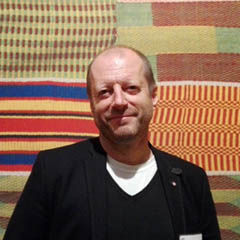The philosophy of borrowing materials and tools, as well as visual motifs, from the local environment goes back to his student days at Kwame Nkrumah University of Science and Technology in Kumasi in the late 1960s. It was the creative efforts of local artisans there that inspired him to become interested in the philosophy of "Natural Synthesis" from 1975 onwards at the University of Nigeria, Nsukka, where he is now Professor of Sculpture. This manifesto of the so-called "Zaria Rebels", whose members included Uche Okeke, at that time also a lecturer in Nsukka, postulated that local traditions should be interpreted using modern materials and techniques. This idea was to have a lasting influence on El Anatsui.
A striking example of its expression in his work is the metal "tapestries" he has made since the late 1990s, which are actually sculptures rather than wall hangings. They consist of thousands of aluminium bottle caps discarded by Nigerian distilleries. Sorted by colour and prepared by El Anatsui's many assistants, they are stitched together with copper wire into "tapestries" several square metres in size. The tiny pieces of aluminium are arranged in patterns that evoke the narrow-band kente textiles made by Asante and Ewe weavers. However, this classical form of West African cloth is subjected by El Anatsui to a radical transformation in these works, which undermine the idea of metal as a rigid material. He transforms into something pliable and almost sensuous. Closely linked to this is the concept of a "nomadic aesthetic" involving fluidity of ideas, impermanence of form and indeterminacy. For El Anatsui this especially includes encouraging and even forcing the curators of his exhibitions to hang his works in accordance with their own ideas. He himself sees his wall hangings as physically unfixed and insists that there is no final and mandatory way of hanging them.
In addition, El Anatsui creates connections with the aesthetic, political and economic roles of textiles – as an important component of global trade and consumer history, and as a significant vehicle for the transfer of ideas and creative ingenuity across cultures. Furthermore, he refers repeatedly to the function of kente cloths as a way of memorializing something, for they are often linked to events, people and historical or current issues: "You can memorialize a lot of things in cloth instead of having a statue in bronze," says El Anatsui and takes this up not only by naming some of his works after kente cloths, but also through the fact that the bottle tops he uses to create his "cloths" come from brands of liquor with names that refer to historical events.
El Anatsui's wall hangings directly continue his idea of creating "transformations" of regional West African phenomena, and experimenting with materials that are important in the local cultural context. His artistic career began with wooden food trays from local markets which he decorated with burned or carved versions of adinkra symbols. The next phase was characterized by a series of broken and partially mended clay pots which served as a reflection on the current political situation in many African countries, and at the same time as an optimistic reference to the fact that clay pots are repairable and new uses can always be found for them: "When a pot breaks it's not the end of its useful life," says El Anatsui. Even breakage can lead to something new.
In the 1980s he again turned to wood as a material, and discovered the chainsaw as a particularly suitable instrument for working African hardwoods. The chainsaw became for him a metaphor of the long history of violence to which the cultural traditions of Africa were, and still are, exposed. "Each process has its own peculiarities or language. [The chainsaw´s] language [is] of violence, of tearing, of clawing, of dividing," says El Anatsui.
In the abstract wood sculptures of this phase the seed is already sown for something that runs through his work to this day: aesthetic comments on globalization and consumer culture, on the wastage of goods – and human lives. It is this aspect that has led to the great popularity of some of his works, for instance "Visa Queue" (1992), and in particular "Akua´s Surviving Children" (1996), which was made in Denmark while he was grappling with the theme of the slave trade. The stylized human figures made of driftwood show the damaging effects of water, wind and weather, the chosen material in itself a symbol of unprotected exposure: "The wood having (like the slaves) been torn from its land source and exposed to the hostile elements of water and wind."
Linking aesthetic creations with political and economic issues is also a characteristic of those works in which he takes up the world's growing ecological challenges. This applies to his "Peak Project", created in 1999, which consists of numerous freestanding "peaks" made from thousands of glittering milk tin lids. Once again, the unfixed nature of the work is a prominent feature, the "peaks" taking on a different shape at each exhibition site. The open-endedness of his works can be seen in "Coal Pot", a work exhibited in the sculpture garden of the University of Kentucky Art Museum. It consists of a 15-feet iron cauldron filled with large pieces of Kentucky coal. In the course of time, the coal will disappear, gradually changing the appearance of the sculpture.
El Anatsui has always been concerned with West African traditions facing the Global North under conditions of modernity, and in his special way he strives to give them new life and meanings that are of relevance today.

